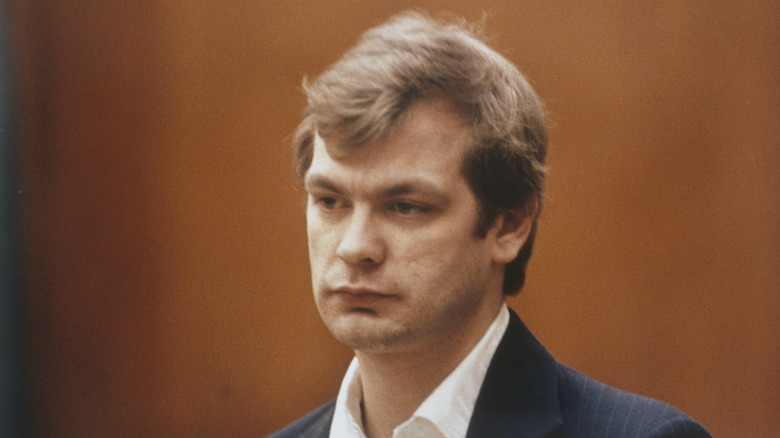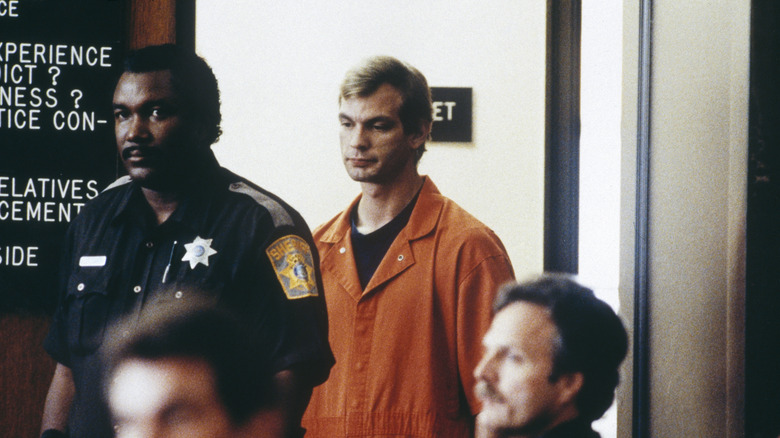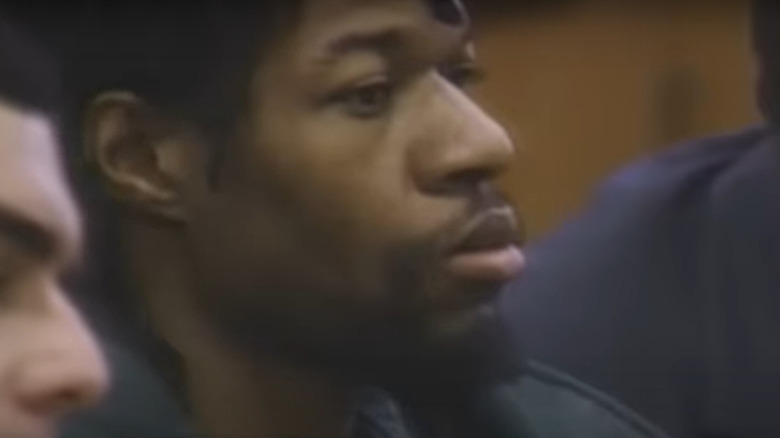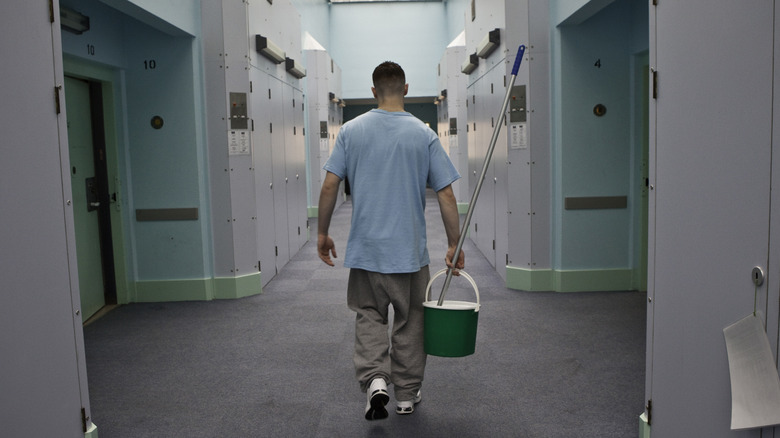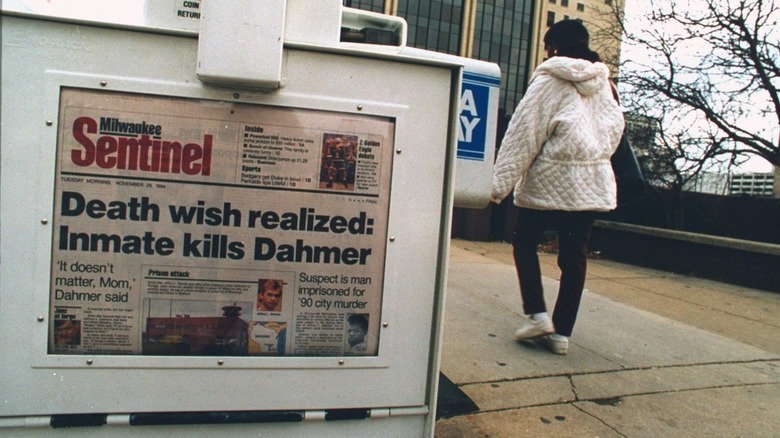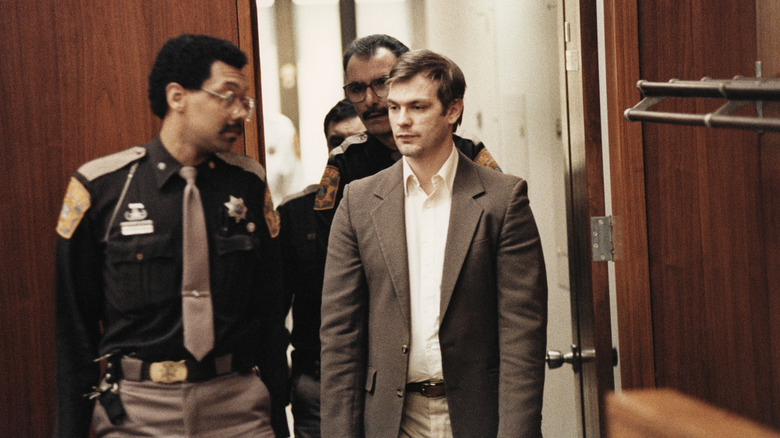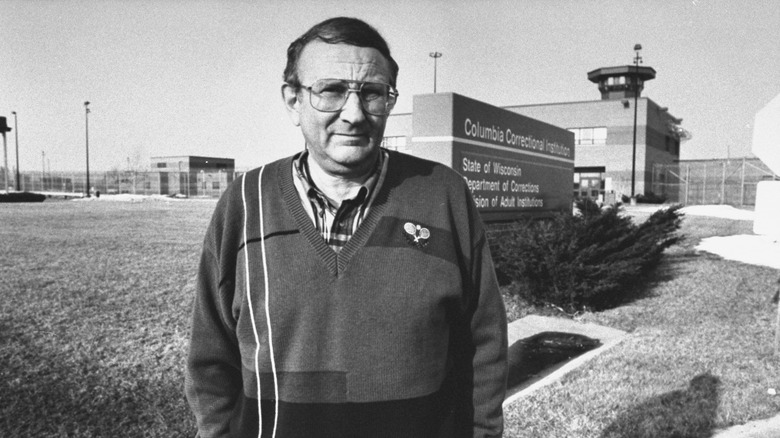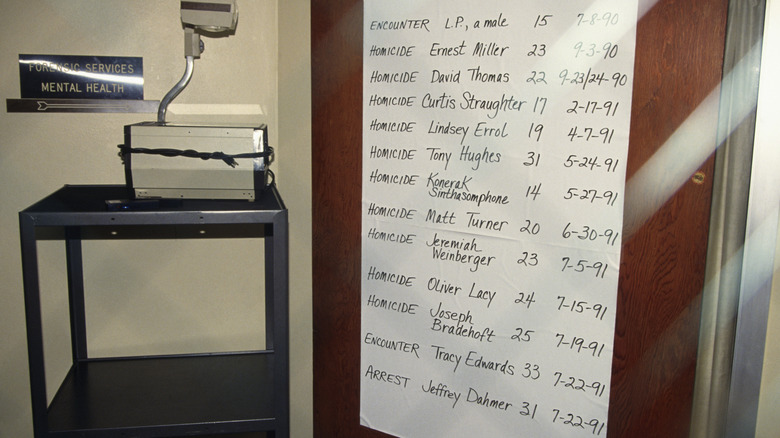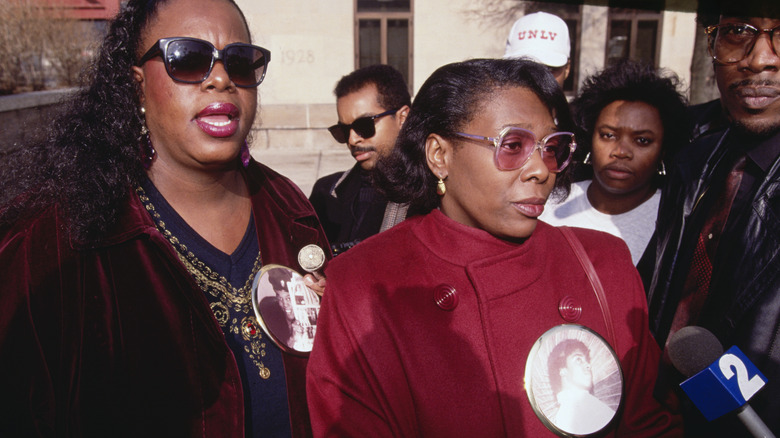What It Was Really Like The Day Jeffrey Dahmer Died
Jeffrey Dahmer will go down as one of the most disturbing serial killers ever. The warning signs started when he was just 4 years old, after Dahmer had a hernia operation that his father claimed changed him. After that, he seemed to get stranger and his behavior more concerning. He was obsessed with death, animal bones (which led to some repulsive interactions with roadkill), and necrophilia, and started drinking to excess when he was just 14. It was just four years later that Dahmer killed for the first time.
After a failed stint in the Army, Dahmer returned home to Ohio where his indecent behaviors saw him arrested multiple times, and at one point was even sentenced to a year in jail (although the judge believed he was sorry and allowed him day release, before eventually letting Dahmer out after just 10 months). Far more concerning was what he wasn't being arrested for: Dahmer had started killing again, and he would murder 16 additional men before he was finally caught. Famously, after killing them, Dahmer did unspeakable things to his victims' bodies.
Dahmer finally stood trial for the murders in 1992. He attempted an insanity defense, but it didn't work. Dahmer was convicted and was given 16 consecutive life sentences. He was placed in the Columbia Correctional Institution in Wisconsin. Just two and a half years later, he would die there, beaten to death by a fellow inmate. This is the story of what happened on Jeffrey Dahmer's last day alive.
It started out like any other day in prison
By the time Jeffrey Dahmer was convicted, his crimes had made him notorious. When he was incarcerated at the Columbia Correctional Institution, for his own safety he was originally put in solitary confinement, which he had agreed to. But solitary is hard on a person, and after a year Dahmer wanted out. One of his lawyers, Stephen Eisenberg, told the AP (via the Bryan Times) after his client's murder, "He wanted to be in with the general population. He didn't want to sit in a hole all day long."
During his time in prison, Dahmer allegedly found God. He'd been baptized in May 1994 by the Rev. Roy Ratcliff. Ratcliff later told the AP that Dahmer felt he had a good relationship with other inmates and wasn't concerned. "There was no sense of dread or fear for his life," Ratcliff claimed. However, other sources claim Dahmer told his family that he simply didn't care if anything happened to him, and his father was worried harm was going to come to his son. Another of Dahmer's lawyers, Gerald Boyle, said, "Dahmer had a death wish, and I know that he didn't have the gumption to do it himself, so I predicted that the day would come when he would be killed in prison" (via Biography).
On the day he died, the serial killer, who once worked in a chocolate factory, was assigned to the work detail he'd held for three weeks: janitorial duties. He was paid 24 cents an hour for the work, and that day, he would be cleaning the gym with two other inmates.
Christopher Scarver was assigned work duty with Dahmer
Convicted murderer Christopher Scarver was one of the other men assigned to work with Jeffrey Dahmer the morning of his death. After dropping out of high school, Scarver joined the Wisconsin Conservation Corps., where he was trained to be a carpenter. After his training year ended, he began misusing drugs and alcohol; Scarver robbed the corps' office a few months later. Three times he was given money by the manager, but each time Scarver declared it was not enough, and shot a third man, Steve Lohman, in the head. Lohman died and Scarver was sentenced to life in prison with the possibility of parole after 50 years in 1992.
Arriving at the Columbia Correctional Institution in the same year as the notorious serial killer, Scarver was aware of who Dahmer was, even if he didn't get to know him. "There was no impression," Scarver told the New York Post. "I never interacted with him." However, that didn't mean Scarver didn't keep an eye on the most famous inmate in his prison. He claims he saw Dahmer taunt other inmates by shaping his food into body parts and pretending ketchup was blood. "He crossed the line with some people — prisoners, prison staff. Some people who are in prison are repentant — but he was not one of them," Scarver said.
But while Scarver may have avoided Dahmer in the cafeteria and the prison yard, he couldn't avoid him when they were assigned work detail together on November 28, 1994.
If you or anyone you know needs help with addiction issues, help is available. Visit the Substance Abuse and Mental Health Services Administration website or contact SAMHSA's National Helpline at 1-800-662-HELP (4357).
A third murderer was also working with Dahmer that day
Jesse Anderson is, of course, not a well-known murderer, and certainly not at the level of infamy as Jeffery Dahmer, but at the time, the murder he was serving a life sentence for was notorious in the area.
On April 21, 1992, Anderson and his wife Barbara ate dinner at a restaurant in Milwaukee. Afterward, while walking out to their car in the parking lot, they were attacked by two Black men, one of whom had been wearing an LA Clippers hat found at the scene. At least, that was the story Anderson, who had lived, told the authorities. Sadly, his wife had not survived the attack, during which she was stabbed and bludgeoned to death. But there had been zero mysterious Black men involved, just her white husband, who had planted the hat himself. Anderson stood trial and received a life sentence.
While Dahmer may have been the focus of Christopher Scarver's anger that morning, he was no fan of Anderson either. Not only was Scarver — as well as many others — furious that the husband had tried to pin his crime on men of color, but he had continued being openly racist in prison. One incident with a portrait of Martin Luther King Jr. particularly stuck in Scarver's mind. "There was a picture in the arts and crafts room that a prisoner had spent a lot of time painting, and he hung it up in that room to dry," Scarver told the New York Post. "[Anderson] painted a blood dot on [MLK's] forehead as if it were a bullet wound."
Jeffrey Dahmer was beaten with a large metal pole
While Christopher Scarver would later claim that he had no plans to kill Jeffrey Dahmer that day, he did come prepared with a weapon. Earlier that morning, Scarver had secreted a 20-inch long metal bar from one of the machines in the gym into the leg of his pants. The guards left the three unshackled inmates to their work at 7:50 a.m. and later, Scarver felt someone poke him. "I turned around, and [Dahmer] and Jesse [Anderson] were kind of laughing under their breath," Scarver told the New York Post. "I looked right into their eyes, and I couldn't tell which had done it."
Eventually, the men split up to clean different areas, but while Anderson went off on his own, Scarver followed Dahmer to one of the gym's bathrooms. There, Scarver confronted the serial killer about his crimes. "I asked him if he did those things 'cause I was fiercely disgusted. He was shocked ... He started looking for the door pretty quick. I blocked him," Scarver said. That's when he beat Dahmer almost to death with the metal rod. Scarver then found Anderson and beat him as well.
Scarver put the murder weapon back in the gym, then returned to his cell. A guard noticed he was back early and asked why. Scarver replied, "God told me to do it. You will hear about it on the 6 o'clock news. Jesse Anderson and Jeffrey Dahmer are dead" (via The Roanoke Times).
The guards were mysteriously absent
While it's not uncommon for inmates to kill each other in prison, in theory, it should have been much harder to kill Jeffrey Dahmer. According to his murderer Christopher Scarver, Dahmer was always followed around by a guard when he was out of his cell, to keep just such a thing from happening. "I saw heated interactions between [Dahmer] and other prisoners from time to time," Scarver told the New York Post.
There had been one very close call already. Osvaldo Durruthy decided to kill Dahmer in the hopes it would get him deported to his home country of Cuba, so he attacked him in the prison chapel with a razor. The attack failed, and Durruthy later told Wisconsin Life, "I went a little a little violent toward an inmate ... I'm not proud of that. At that moment, my mind was so disturbed."
So it is more than a little strange that while there were three guards in the vicinity on the day Dahmer died, none were actually overseeing the work detail like they were supposed to. Allegedly, one guard was listening to music, another was in a back office, and the third was escorting two prisoners to the gym. Scarver thinks Dahmer was unprotected on purpose, telling the Post that the guards hated the serial killer as much as anyone. "They had something to do with what took place. Yes," Scarver said. Legally, the guards were not considered criminally liable, although Wisconsin did form a panel to look into supervised work duties after the murders occurred.
Dahmer died about an hour after he was attacked
When Christopher Scarver told a guard that Jeffery Dahmer and Jesse Anderson were dead, that wasn't quite true. At the time, both of them were still alive. Dahmer was found in a puddle of blood at 8:10 a.m., emergency services were called, and Dahmer and Anderson were taken to the nearby Divine Savior Hospital. The infamous serial killer had been beaten so badly about the head that he was hard to recognize. One of the paramedics, Craig S. Ratz, didn't recognize Dahmer because of his injuries and the oxygen mask covering part of his face. He told the AP (via the Wausau Daily Herald), "There was a substantial amount of blood." Another man who saw him, Fire Chief Ettore Castellente, said, "He didn't look like his former pictures."
Dahmer lived about an hour after he was beaten, being pronounced dead a little after 9 a.m.; he was 34 years old. The following day, the preliminary autopsy results were announced, which found he had died of multiple skull fractures and brain trauma brought about by two blows to his head. And what happened to Jeffrey Dahmer's body after he was murdered? His will requested he be cremated immediately, but because of the court case against Scarver and a dispute over Dahmer's remains by his divorced parents (his father is pictured above), his full body would not end up being incinerated for over a year.
Anderson lived for two days after the attack, dying at the University of Wisconsin Hospital. He was 37 years old.
The press wanted to know if the attack was racially motivated
Jeffrey Dahmer's murder trial had been a media circus, for obvious reasons. The grisly details were gold to newspapers and other media sources. As soon as word was out that Dahmer had been killed violently, the press went into a frenzy again.
Hours after Dahmer's death, details about his killer had not yet been released, but when the authorities held a press conference, the media wanted to know whether the suspect in the double homicide was Black. This was because both Dahmer and Jesse Anderson's crimes had a racial element to them. In Dahmer's case, most of his victims (listed above) were young men of color, while Anderson had tried to pin his own crime on nonexistent Black men. Authorities declined to say the race of the suspected attacker of the two murderers, but explained they did not at that time believe there was any reason to think race was a motivation behind the crime.
The media also descended on the home of the serial killer's father the same day his son was murdered, as well as Jeffrey Dahmer's old apartment where many of the victims had died or their body parts had been found. They even began badgering the family members of the victims with calls looking for comments on how they felt that their loved ones' killer had just been brutally murdered himself. At least one victim's father told the press he just wanted to be left alone.
The family members of Dahmer's victims reacted differently to his murder
As the news of Jeffrey Dahmer's death spread that afternoon and evening, emotions ran high. The AP reported (via the Wausau Daily Herald) that a random passerby in Dahmer's old neighborhood in Milwaukee screamed out, "If you kill anybody like that, you deserve to die like you did." One former neighbor said rumors were that Dahmer hadn't suffered nearly enough, while another neighbor said, "I would have let the families take turns with him. I hope whoever did this gets a reward." That was decidedly not the opinion of E. Michael McCann, the district attorney who put Dahmer behind bars for the killings. "This was murder," he said. "I hope whoever did this doesn't emerge as a folk hero."
It was the families of the victims, though, who were most impacted. They had wildly different reactions to the news. The grandmother of victim Curtis Straughter said, "So you do, so you get." The mother of victim Anthony Hughes told the AP (via The Times-Herald), "It's nothing to rejoice about." And the mother of victim Oliver Lacey said (via Yahoo News), "The hurt is worse now, because he's not suffering like we are."
The varying thoughts expressed immediately after learning Dahmer died might be explained by the trauma he'd brought these families, even beyond killing their loved ones. A councilor for several of the families told Newsday, "Every incident with Dahmer ... opens up yet another wound."
